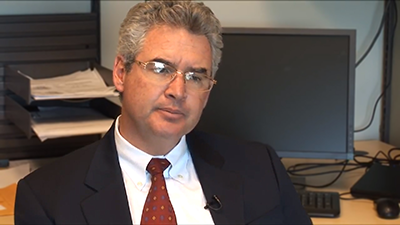2018 Bolivar Award Winner Uses Modern Spectroscopy to Answer Century-Old Questions

Emil Kraepelin did not have the tools needed in the late 19th and early 20th centuries to prove his hypothesis that people with schizophrenia (or dementia praecox as it was called at the time) experience continual declines in brain function, but if he were alive today, he would probably be pleased by what structural and functional brain imaging is now capable of showing.
So said Juan Bustillo, M.D. (pictured above), a professor of psychiatry at the University of New Mexico and the recipient of APA’s 2018 Simon Bolivar Award, during the session titled “How Is the Schizophrenia Brain Changing: Was Kraepelin Right?”. The Bolivar award is presented each year to a prominent advocate for Hispanics and is designed to sensitize APA members to the mental health problems and goals of Hispanics.
While neuroimaging has confirmed that subtle reductions in brain volume occur during the course of schizophrenia that cannot be exclusively attributed to antipsychotic medications, the causes of the changes and their impact on symptoms remain a mystery.
Fortunately, the brain has a lot of water, Bustillo said, which allows a technique known as proton magnetic resonance spectroscopy (MRS) to provide valuable insight into brain biochemistry. Using MRS, Bustillo and his group have found that the brains of people with schizophrenia contain more glutamate per volume than controls and that this glutamate concentration increases gradually with age. Similar patterns are not seen in patients with bipolar disorder, suggesting that glutamate accumulation may be specific to schizophrenia and not associated with manic and disorganized states.
Three regions in particular show significant increases in glutamate compared with controls or bipolar patients—the left lentiform nucleus, right insula, and left medial frontal cortex. These three regions share one other feature: they are all part of the salience network. This network, which has been linked with schizophrenia, diverts resources between the default mode network (involved in daydreaming) and central-executive network (which controls active cognitive tasks) as needed, Bustillo said.
Bustillo speculated that over time, the excess glutamate activity in these regions results in an “excitotoxicity” to the neurons and causes the salience network to be less efficient at transitioning between the default mode and central-executive networks. This can result in problems such as disorganized thinking, more uncertainty in memory, and poor self-monitoring—classic signs of early psychosis.
“Skeptical clinicians remind me that glutamate-modulating therapies like memantine or cycloserine have so far been unsuccessful at treating psychotic symptoms,” said Bustillo, who becomes the third Colombian native to receive the Bolivar Award since its inception in 1975. “But we do not know yet if these glutamate therapies may improve some of the structural problems seen in the brains of people with psychosis.”
If that is the case, then perhaps providing these medications earlier in the course of illness, or for longer periods, might have clinical benefits.
|
|
|
|
Advertisement
 |
|
 |
|
|

